1866 Antique CIVIL War Book Military History Union Confederate Color Plates Map



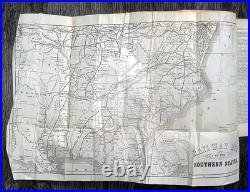







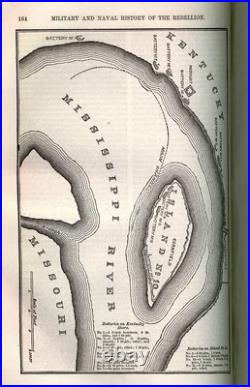
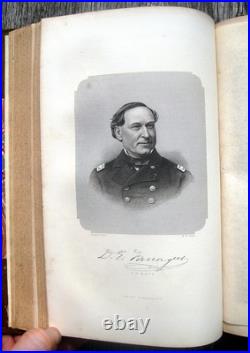




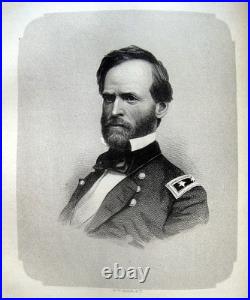
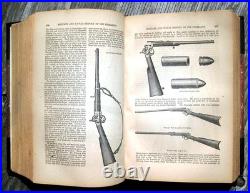
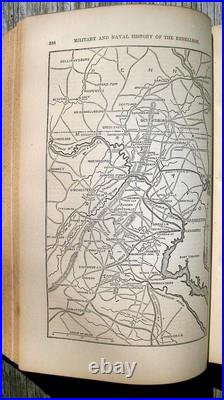
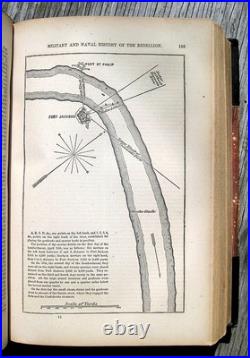
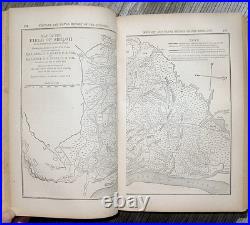



Note: Many of my clients are scholars and researchers seeking specific information related to their field of interest. For their convenience I include the following details directly from this book. Places and Historical Subject Matter Discussed in this Book (See Full Contents Below): Civil War Military History Army Navy United States American History Antique Illustrated Leather Binding Railroad Railway Map Union Confederate Confederacy CSA Federal Forces Great Rebellion War Between the States Slavery Slave Secession States North South Northern Southern Troops Regiments President Abraham Lincoln Jefferson Davis General Ulysses S. Lee Yankee Rebel Dixie Battle of Attack Battles Siege South Carolina Florida Mississippi River Alabama Georgia Louisiana Washington D. Augustine Hilton Head Pea Ridge Columbus Island No. 10 Gunboats Shiloh Corinth New Orleans Mortar Fleet Farragut Manassas Army of the Potomac Yorktown Williamsburg Merrimac Norfolk Drury's Bluff Chickahominy Shenandoah Valley Fremont Jackson Banks Cross Keys Port Republic Fair Oaks Mechanicsvllle Savage Station White Oak Swamp Charles City Cross Roads Peninsula Cedar Mountain Louisa Court House Pope Catlett's Station Bristow's Gainesville Chantilly Maryland South Mountain Antietam Emancipation Proclamation Guerillas Perryville Bragg Cumberland Gap Iuka Rosecrans Stone River Fredericksburg Port Royal Baton Rouge Donaldsonville Vicksburg Natchez Indian Territory Northwestern Indians Holly Springs Haines' Bluffs Red River Grand Gulf Big Black Jackson Yazoo Port Hudson Brashear Semmesport Rappahannock Hooker Chancellorsville Stonewall Jackson Winchester Martinsburg Pennsylvania Meade Gettysburg Morgan Chesapeake McAllister Chickamauga Morris Island Sherman Meridian Olustee Fort Pillow Atlanta Spottsylvania James Fort Darling Pamunkey Coal Harbor Lynchburg Beams' Station Hatcher's Run Ogeechee Savannah Albemarle Mobile Bay Kearsarge Fortress Monroe Columbia Fayetteville Wilmington Cheraw Averysboro Bentonville Petersburg Five Forks Raleigh. THE MILITARY AND NAVAL HISTORY OF THE REBELLION IN THE UNITED STATES. With Biographical Sketches of Deceased Officers. Appleton & Company, New York. Illustrated with steel plate portraits, color lithos, text illustrations, maps and plans. Condition: VERY GOOD ANTIQUE CONDITION.
Exterior has minor wear as shown in photos but nothing affecting integrity. Text is clean and complete. No torn, loose or missing pages. Map had some tears however these have been repaired with archival document tape; some edges are folded under but intact. Very old inscription inside front cover.
Wonderful example of this highly detailed, beautifully illustrated Civil War history published only one year after the war ended. This is a thorough and authoritative account of all the military and naval engagements of the Civil War. Published by the prestigious D. Appleton & Company of New York, this handsome volume presents in factual, documentary style a concise analysis of every major clash between the Blue and the Gray. The design of this work is to present in one volume the military and naval scenes of the great contest recently closed. It contains not only all the principal battles by land and sea, but every important skirmish. The plans and objects of the various campaigns are clearly stated, and the progress of the armies, step by step, in their execution, is described and illustrated with distinct topographical maps, chiefly obtained from official sources. The important naval conflicts are described and illustrated in similar manner. Portions of the work have been submitted to the inspection of distinguished military officers, relating to operations by armies under their command, and received their approval for its completeness and accuracy. But it is not merely a work of skirmishes and battles. The manner of raising, organizing, and equipping the armies and fleets is stated in detail; also the sanitary measures for their preservation, including hospitals and charitable organizations; the improvements in the weapons and forts and floating batteries of military and naval warfare; the treatment of prisoners, and the action relative to those military questions arising between combatants. It also embraces a statement of the civil and political proceedings incidental to the war, which took place previous to its commencement or during its progress; such as the secession of the Southern States, and the organization of their Confederacy; the political issues of the war and the triumph of emancipation, with the treatment of colored men, whether soldiers or freedmen, and all other subjects properly a portion of its direct history. It concludes with biographical tributes to the principal military and naval officers who have fallen in the contest. Accompanying the 843 pages of text are a number of steel portrait engravings and three full-page color lithos that have all the beauty of miniature paintings. There are also black and white text illustrations and a series of maps and plans showing battle scenes, harbor plans, etc. - including a large foldout railroad map entitled Railways of the Southern States. This is a scholar's history of the Civil War.Unlike many other books published in the immediate wake of the war, THE MILITARY AND NAVAL HISTORY OF THE REBELLION IN THE UNITED STATES avoids sentimentality and florid prose. It is written in a stately, informative manner to impart facts rather than inflame passions. The author takes no side; whether speaking of the Union or the Confederacy, he remains dutifully objective. Another singular aspect of this book is its lengthy section of biographical sketches of fallen military officers of both Union and Confederate loyalties.
More than 350 biographical sketches in all, covering more than 100 pages. Here, brief biographies of relatively unknown officers who were killed in action appear alongside those of slain historical figures such as Admiral David Porter, Major-General J. This is a very rare and highly collectible history of the great rebellion.CHAPTER ONE: Secession Movements In South Carolina, Florida, Mississippi, Alabama, Georgia, and Louisiana. CHAPTER TWO: Preparations for a Southern Confederacy Meeting of Congress at Montgomery Members and Organization Inauguration of a President His Addresses Cabinet Proceedings of the Congress New Constitution.
CHAPTER THREE: Inauguration of President Lincoln Southern Commissioners sent to Europe and Washington Time for War had come Despatches from Montgomery to General Beauregard at Charleston Condition of Fort Sumter Occupied by Major Anderson Excitement Surrender demanded by Gov. Pickens Negotiations at Washington Preparations for attack on the Fort Women and Children removed Evacuation demanded by General Beauregard Correspondence Attack on the Fort Its Surrender Action of the Federal Government to relieve it. CHAPTER FOUR: State of Affairs Action of the Union States Proclamation of the President calling for men on the surrender of Fort Sumter Response of the Northern and Central States Attack on Massachusetts troops in Baltimore.
CHAPTER FIVE: Proceedings in Texas to effect Secession, and Military Movements Action in Virginia and Military Movements Action in Arkansas and Military Movements Action in North Carolina and Military Movements Action In Tennessee and Military Movements. CHAPTER SEVEN: Southern Congress adjourns to meet at Richmond Speeches of Howell Cobb and Vice-President Stephens The Federal Army Skirmish at Phillippi Attack on Neetmok Pig's Point Great Bethel Movements In West Tennessee Romney Advance of General Lyon to Jefferson City Vienna Locomotives Destroyed Mathias Point Other Events Southern Privateers. CHAPTER EIGHT: March of General McClellan Into Western Virginia His Address to the Inhabitants Surprise at Phillippi Battle at Laurel Hill Defeat and Surrender of the Enemy Manassas Position of the Northern and Southern Armies Forces of General McDowell Advance to Centrevllle Battle of Bull Run Retreat. CHAPTER NINE: Extra Session of Congress Its Action Strength of the Army Southern troops organised Skirmishes In Missouri At Monroe Station, Millville, and Fnlton Movements of General Lyon Battle of Wilson's Creek Surrender of Major Lynch In New Mexico Skirmishes Attack on Galveston Expedition against the forts at Hatteras Inlet.CHAPTER TEN: Campaign of Gens. Wise, Floyd, and Lee, In Western Virginia The Campaign of Geo. Fremont in Missouri Affairs in Kentucky Neutrality abandoned Occupation of the State by troops Military Operations. CHAPTER ELEVEN: Attack on Wilson's Regiment Bombardment of Fort Pickens Burning of Warrenton Attack on the Federal fleet at the mouths of the Mississippi Repulse at Ball's Bluff Expedition against Port Royal: its success Resignation of Lieut-General Scott Battle at Belmont Capture of Messrs.
Mason and Slidell Occupation of Aocomac and Northampton Counties, Va. CHAPTER TWELVE: Views of the Combatants Condition of the Federal Navy Its Increase Iron-Clads Western Fleet Numbers and position of the hostile Armies Campaign in Eastern Kentucky Battle of Mill Springs Death of Zollicoffer Campaign in Western Kentucky and Tennessee Federal Troops engaged Capture of Fort Henry Surrender of Fort Donelson Advance of General Buell Surrender of Nashville. CHAPTER THIRTEEN: General Burnside's Expedition sails The Fleet and Transports In a Storm Advance up Pamlico Sound Capture of Roanoke Island Other Operations Provisional Government set up in North Carolina Operations in South Carolina, Bombardment and surrender of Fort Pulaski Operations in Florida Capture of Femandina, Jacksonville, and St Augustine Other Naval Operations Treatment of Slaves by the Federal Government Organized as Troops at Hilton Head. CHAPTER FOURTEEN: Military Operations in Missouri and Arkansas Advance of General Curtis His Address to the People of the Southwest Battle of Pea Ridge Retreat of General Price Further Operations Advance of the Fleet against Columbus, Ky.
Evacuated Further progress down the Mississippi Island No. 10: its Bombardment Gunboats pass the Batteries In the night Evacuation of the Island Advance of the Fleet toward Memphis Naval Battle before the City Its Surrender Occupied by Federal Troops Proceedings during the Tear.
CHAPTER FIFTEEN: Advance of General Grant up the Tennessee River Position of the Southern Forces Movements of General Buell Advance of General Johnston to attack General Grant Doherty's description Commencement of the Battle at Shiloh Arrival of General Buell Second day of Battle Retreat of Southern Troops Message of Mr. Davis to Congress at Richmond Arrival of General Halleck March on Corinth Its Evacuation Movements of General Mitchel Provisional Government in Tennessee Its Proceedings. CHAPTER SEVENTEEN: Position of the forces near Washington Movements of General Lander Fortifications at Manassas Plans of General McClellan Evacuation of Manassas Commanders appointed by the President Advance of the Army of the Potomac by water Delay of General McDowell Safety of Washington New Departments created Advance of the Army of the Potomac on Yorktown Its Siege Evacuation Pursuit by the Army of the Potomac Evacuation of Williamsburg Naval Battle and destruction of the Iron-clad Merrimac Capture of Norfolk Attack on Drury's Bluff Advance of the Army of the Potomac up the Peninsula Position on the Chickahominy Withdrawal of General McDowell.
CHAPTER EIGHTEEN: Junction of General Shields with General McDowell Both ordered to the Shenandoah Valley March of General Fremont to the same point Previous advance of General Banks up tbe Shenandoah Position of the Forces Advance of General Jackson down the Volley Attack at Front Royal Retreat of General Banks Excitement In the Northern States General Jackson falls back Pursuit by Gens. Fremont and Shields Battle at Cross Keys Battle at Port Republic Advance of General Heath. CHAPTER NINETEEN: General McClellan crosses the Chickahominy Battle of Fair Oaks Retreat of the Enemy March In the rear of General McClellan Bridges over the Chickahominy completed Battle at Mechanicsvllle General McClellan moves toward the James Battles at Savage Station, White Oak Swamp, and Charles City Cross Roads Confusion of the Enemy Attack at Malvern Hill Army at Harrison's Landing Arrival of General Halleck His Views Army of the Potomac withdrawn from the Peninsula.CHAPTER TWENTY: General Pope takes command of the Army of Virginia Call of the President for more Men Advance of General Leo Battle of Cedar Mountain Capture of Louisa Court House General Pope falls back Dash on Catlett's Station Further advance of the Enemy Attack at Manassas Attack at Bristow's Station Battle near Manassas Battle at Gainesville Doherty's description Battle near Bull Run Excitement In the Northern States Retreat of General Banks Battle at Chantilly Retreat of General Pope to the fortifications at Washington. CHAPTER TWENTY-ONE: Advance of General Lee into Maryland His Address to the People General McClellan ordered to take command at Washington His Orders Advances Into Maryland to meet General Lee Confidential Order of General Lee Battle of South Mountain Attack of the Enemy on Harper's Ferry Its Surrender Battle of Antietam Retreat of General Lee.
CHAPTER TWENTY-TWO: Message of the President recommending Emancipation with Compensation His Conference with Members of Congress Proclamation threatening Emancipation Finances of the Federal Government Increase of the Armies Efforts of the South to raise Armies Conscription Officers of the Southern Government Its Finances Its Navy Department Cruisers The Oreto The Alabama: vessels destroyed by her Other Operations Diplomatic Correspondence with the British Government. CHAPTER TWENTY-THREE: Guerillas in Kentucky Invasion of the State by General E. Kirby Smith General Buell falls back from Tennessee as General Bragg advances toward Kentucky Movements In Kentucky Battle at Perryville Retreat of General Bragg Cumberland Gap Invasion of West Virginia Operations In Mississippi Battle of Iuka Battle at Corinth Retreat of the Enemy Expedition of General Hovey General Rosecrans takes command in Tennessee Position of General Bragg's Forces Battle of Stone River. CHAPTER TWENTY-FOUR: Conclusion of the Campaign in Virginia General McClellan crosses the Potomac Causes of his Delay Presses General Lee General Burnside ordered to take Command His Orders General Lee falls back Advance of General Burnside toward Fredericksburg Its Surrender Demanded Occupied by General Lee Battle of Fredericksburg Withdrawal of General Burnside's Forces Losses.CHAPTER TWENTY-FIVE: Attempt to capture Washington, North Carolina Expedition from Port Royal Attack on Baton Rouge Contest near Donaldsonville Attack on Vicksburg Surrender of Natchez Capture of Galveston Attack on the Federal Fleet and capture of several Vessels Military Operations In New Mexico Expedition to the Indian Territory Operations In Arkansas and Missouri Campaign against the Northwestern Indians Results of the Year. CHAPTER TWENTY-SEVEN: The Campaign against Vicksburg The plan of General Grant The loss of Holly Springs: Its consequences Movement of General Sherman toward Vicksburg Haines' Bluffs Attack of General Sherman on Chickasaw Bluffs Failure Address to his Troops Movement up the Arkansas River Capture of Arkansas Post Retires to Young's Point Arrival of Gen Grant Work on the Canal opposite Vicksburg Floods Queen of the West runs the Batteries at Vicksburg Her Expedition down the Mississippi Captures Loss of the Queen of the West Scenes up the Red River Approach of the Enemy's Gunboats The Indianola runs the Batteries Her Destruction Attempt of General Grant to cut a Channel to Lake Providence: also one to Moon Lake Expedition of Admiral Porter Its Failure. CHAPTER TWENTY-EIGHT: Object of General Grant to reach the rear of Vicksburg His Movements Transports and Gunboats run the Batteries Attack on Grand Gulf Crossing the Mississippi by the Army Change of base by General Grant Raid of Col. Grierson through Mississippi Advance of General Grant to the Big Black River Battles Occupation of Jackson March on Vicksburg Battles March of General Sherman to the Yazoo Investment of Vicksburg Siege Surrender Results.
CHAPTER TWENTY-NINE: Campaign of General Banks The Naval Force Action with the Batteries at Port Hudson March of General Banks west of the Mississippi Action at Brashear Advance upon Alexandria Its Capture March to Semmesport Crossing the Mississippi Attack on Port Hudson Its Investment Siege Surrender. CHAPTER THIRTY-ONE: Position of the hostile Armies on the Rappahannock The Military Departments Advance of General Lee toward the Shenandoah Valley Capture of Winchester and Martinsburg Invasion of Maryland and Pennsylvania Calls for Troops from the Northern States March of General Hooker's Army Plans of General Lee The Enemy in Pennsylvania. CHAPTER THIRTY-TWO: Position of the Army of the Potomac General Hooker relieved by General Meade Concentration of the Enemy near Gettysburg Opening of the Battle The Battle Retreat of General Lee Pursued by General Meade Cooperating Movements elsewhere Advance of General Rosecrans In Tennessee against General Bragg Raid of General John Morgan in Ohio. CHAPTER THIRTY-THREE: Measures taken in the Insurrectionary States to recruit their Armies The Army of the United States Conscription The Draft: how made Riots in New York, Boston, and elsewhere Employment of Colored Troops Proceedings relative theroto Organization of Hospitals Expenditures Materials Ordnance and Small Arms. CHAPTER THIRTY-FOUR: Operations of the Florida and Alabama The bark Tacony Capture of the Chesapeake Damage to Federal Commerce Increase of the Federal Navy Operations of the North Atlantic Squadron Operations of the South Atlantic Squadron Attack on Fort McAllister Attack on Charleston Capture of the Atlanta Other Naval Operations.CHAPTER THIRTY-FIVE: Situation of General Rosecrans Attack on Fort Donelson Expeditions of Colburn, Sheridan, Hall, and Col. Streight Advance of General Rosecrans Retreat of General Bragg Movement of General Burnside Other Movements Occupation of Chattanooga Further advance of General Rosecrans Battle of Chickamauga Firmness of General Thomas Army concentrates at Chattanooga. CHAPTER THIRTY-SIX: General Grant ordered to the command at Chattanooga Defeats General Bragg Movements of General Burnside in East Tennessee Position of the Armies In Virginia Advance of General Meade to Mine Run General Gillmore's Operations before Charleston Captures Morris Island Opens fire on Fort Sumter and Charleston Movements of General Banks in Texas Operations in Missouri and Arkansas Operations against the Indians in Minnesota Desolations by the Armies. CHAPTER THIRTY-SEVEN: Progress of Civil Affairs Finances of the Insurrectionary States Decay of Railroads Crops Mission of Mr. CHAPTER THIRTY-EIGHT: Position of the Armies at the beginning of 1864 General Sherman's march to Meridian Opposing movements of the Enemy General Gillmore's movements In Florida Battle of Olustee Campaign of General Banks on the Red River Battles Cooperation of General Steele Its Results Capture of Fort Pillow and slaughter of the Garrison Unsuccessful Operations in North Carolina.
CHAPTER THIRTY-NINE: Desultory Operations In Virginia General Grant appointed Lieutenant-General Reorganization of the Army of the Potomac General Sherman's Campaign against Atlanta Its Plan Battles Manoeuvres approaching Atlanta Its Evacuation Correspondence with the Authorities Civilians sent away. CHAPTER FORTY: Reorganization of the Army of the Potomac Plans of General Grant Advance of the Army under General Grant Crosses the Rappahannock First Day's Battle Position of the Armies at Night Burnside's Reserve brought on the Field Subsequent Battles March to the Left Battles at Spottsylvania Court House Thanksgivings at the North Disposal of the Wounded.
CHAPTER FORTY-ONE: Strength of the Army of the Potomac Cooperating Movements Cavalry Raid to cut General Lee's Communications Advance of General Averill In West Virginia Advance of Gens. Crook and Sigel Defeated by General Breckinridge Movement of General Butler up the James Attempts to cut the Railroads Attack on Fort Darling Expedition of General Kautz. CHAPTER FORTY-TWO: Concentration of Troops under General Lee Attempt to turn the Right of Gen Grant's Line New Movement to the Left General Grant reaches the North Anna Position of the Armies General Grant crosses the Pamunkey Reinforcements from General Butler Battle at Coal Harbor Failure of the attempt to push the Enemy across the Chickahominy Crossing the James Movement of General Butler on Petersburg Failure Other Movements General Grant before Petersburg Condition of the Army. CHAPTER FORTY-THREE: The Second Movement against Lynchburg Gens.
Crook, Averill, and Hunter Movement of General Morgan Advance of General Hunter Capture of Staunton, Lexington, &c. He retreats to West Virginia Invasion of Maryland Defeat of General Wallace Approach of the enemy to Baltimore Attack on Washington The Enemy retire Other Movements Changes in the command of the Army of the James Explosion of a Mine before Petersburg Battle at Beams' Station Hatcher's Run. CHAPTER FORTY-FOUR: The Sanitary Commission Its Organization Objects Means of Transportation Preventive Service General Relief Special Relief Field Relief Auxiliary Relief Corps Receipts Expenditures Western Commission Other Sanitary Commissions Christian Commission Organization Objects Services American Union Commission Objects.
CHAPTER FORTY-FIVE: Position of General Sherman at Atlanta Position of General Hood: his Movements Operations of General Forrest The failure to Interrupt the Federal Communications Plans of General Sherman His Orders Distribution of his Army Advance of the Left Wing Excitement in Georgia Advance of the Right Wing Reaches the Ogeechee Demonstration toward Augusta Advance between the Ogeechee and Savannah Rivers Scouts reach the Coast Reduction of Fort McAllister Investment of Savannah Its Evacuation Farther Proceedings. CHAPTER FORTY-SIX: General Sheridan takes command on the Upper Potomac Attack on Fisher's Hill March of Sheridan up the Shenandoah Sudden Attack of the Enemy Their Repulse and Pursuit Guerrillas Movements of General Price in Missouri Investment of Nashville by General Hood Battles Retreat of Hood and pursuit by General Thomas Expedition against the Mississippi Central Railroad from Baton Rouge Movements of General Warren against the Weldon Road. CHAPTER FORTY-SEVEN: Naval Operations The Stonewall Other Cruisers Capture of the Roanoke Increase of the Federal Navy Operations of the North Atlantic Squadron Blockade Action with the Albemarle Her Destruction Operations in James River Attack on Fort Fisher Repulse Correspondence Attack Renewed Capture of the Fort West Gulf Squadron Capture of the Forts at Mobile Bay Action between the Kearsarge and Alabama Capture of the Florida. CHAPTER FORTY-EIGHT: Number of Southern Troops Measures to arm the Slaves Objections Recruiting the Union Armies Military Departments Condition of the Southern States Debt Paper Currency Peace Movements Gillmore and Jacques Unofficial Conference at Clifton Proceedings at Fortress Monroe Report of President Lincoln Report of Messrs. CHAPTER FORTY-NINE: Progress of Military Operations General Thomas' position in Tennessee General Hood's position in Tennessee Movement of the Enemy on the James River Another Battle at Hatcher's Run March of General Sherman from Savannah Capture of Columbia, S. C Evacuation of Charleston Advance to Fayettevilie Transfer of General Schofield to North Carolina Capture of Wilmington Advance of General Sherman to Cheraw Battle at Averysboro Battle at Bentonville Arrival at Goldsboro Results of Sherman's March. CHAPTER FIFTY: March of General Sheridan from Winchester to the James River Attack on the Army before Petersburg Movement of Troops by the left of General Grant Battle near live Forks Cannonade of Petersburg Assault on the City General Leo orders the evacuation of Richmond and Petersburg Occupation of the latter by Union Troops Occupation of Richmond by General Weltzel Retreat of General Lee's Army Pursuit by General Sheridan Surrender of General Lee Terms of Capitulation. CHAPTER FIFTY-ONE: March of General Stoneman from East Tennessee to Salisbury Advance of General Sherman upon Raleigh General Johnston proposes a Conference The Conference and Terms agreed upon Rejected at Washington Surrender of General Johnston's Army March of General Wilson in North Alabama Capture of Mobile Surrender of General Taylor's Army Surrender of General E.Kirby Smith Disbandment of the Armies Farewell of General Sherman Farewell of General Grant Capture of Mr. Davis Amnesty Proclamation Measures to establish Civil Governments In the States List of Army Officers. BIOGRAPHICAL SKETCHES OF DECEASED OFFICERS.
UNION: Ephraim Elmer Ellsworth John Trout Greble Major Theodore Winthrop James Harman Ward Major Sullivan Ballou Col. Otis H Tillinghast Captain Levi Tower Colonel William D Kennedy Nathaniel Lyon Cary Gratz Col. John Williamson Edward D Baker William Lowell Putnam Brig. General William Frederick Lander Col.
Miles J Fletcher Charles Ferguson Smith General William H. Keim Col Oliver H Ripley Col. Isaac M Tucker William Henry Milnor Col.
George T Roberts Brig-General Thomas Williams Lt. Crane General Heinrich Bollen Col. General Philip Kearney Isaac Ingalls Stevens General George B. Dixon H Miles Joseph King Fenno Mansfield Col J H Childs Col. Col Philip J Parisen Col. Wilder Dwight William Nelson General Pleasant Adam Hackleman Col. Kirby Smith William Dean Colman General James S.Jackson General William B Terrill George Webster Captain Greer Tallmadge Major Ira L Hewitt Ormsby McKnight Mitchel Israel B Richardson General Charles Davis Jameson Commodore Garrett J Pendergrast Brig General Francis E Patterson Reverend Arthur B Fuller Brig. General George D Bayard Lieut. Col Joseph Bridgham Curtis Brig. General Conrad Feger Jackson Col. George W Roberts J W Schaeffer Brig.
General Joshua Woodrow Sill William B Renshaw Commander Jonathan M. Edward Lea Commander William Gwin Brig. Warren Stewart Edward Smith Gilbert Henry N Fisher, M.
Acting Master Robert L Kelly Major-Gen Edwin Vose Sumner Brig. Edgar A Kimball Benjamin Welch Lieut. Edward Cobb Charles Hiram George Berry Lieut.
Francis Eugene Butler Joseph B. William Oliver Stevens Brig-General Amiel W Whipple John E Holmes General George Boardman Boomer Col. Col William Logan Rodman Major Massett Col. Benjamin F Davis Reverend James Averill Lieut-Col. Abel Smith Andrew Hull Foote Col.
Patrick H O'Rourke Col. Gen Stephen H Weed Samuel K Zook Brig. General Elon J Farnsworth Col. Paul Joseph Revere Commander Abner Read Col.Henry T O'Brien Acting Brig. Gen Haldimand Sumner Putnam Col.
Robert Gould Shaw Major Daniel McCook Brig. Gen George C Strong Lieut. George Nauman Commodore Henry W Morris Brig-General Benjamin Welch Brig. General Roswell Sabine Ripley Col. General William Haines Lytle Major Edward B.
General Louis Blenker Major Gilbert Malleson Elliott Brig. General William P Sanders John Buford Commodore Gershom J Van Brunt Capt.
George W Vanderbilt Rear Admiral Geo W Storer Col. Saunders Stephen G Chaplin Capt.
Allan Ramsay Commander Dawson Phenix Col. Geza Miholotzi Kennedy Stewart M. George H Ringgold Reverend William H Gilder Lieut. Com Charles W Flusser Franklin Hulse Clack Rev. James H Schneider Commodore William David Porter Col.
Alford B Chapman Brig-Gen Alexander Hays General John Lloyd Thomas Colden Cooper Brig. Gen James Samuel Wadsworth John Sedgwick Col. Herman Hacke Thomas G Stevenson James Clay Rice Charles Brooks Brown Rev.
George B Hall Commander Edward A Barnet Col. Edward Pye John K Hardenbrook William Wheeler Brig General Charles G Harker Col. Gen James E Blythe Brig. Gen Samuel A Rice Col. Dan McCook Brig-Gen Lucien Greathouse James Birdseye McPherson Col. James A Mulligan Silas Miller Capt Tunis Augustus Craven John Faron Col. Abel D Streight Brig-Gen Daniel Phineas Woodbury Commander James M Duncan Col.Carter Van Vleck Dr W H Rulison Col William T C Grower Col. Freeman McGilvery Brig-Gen Milo S Hascall Col James C Clark Brig-Gen Joshua B Howell Brig-General David A Russell Brig-General Hiram Burnham Col N E Welch Lieut. John R Meigs Col J C Thomas Col.
John P Sanderson Daniel Bell Birney Briog-Gen Daniel D Bidwell Col. Joseph Thorburn Charles Russell Lowell Col. Gen Thomas E Greenfield Col. De Forrest Captain Louis Bell Brevet Brig. Robert Montgomery Smith Jackson Lieut. Col Lewis Ledyard Weld Col. Commander Marshall Campbell Maj-General William H C Whiting Brevet Brig-General Frederick Winthrop Col. Hugh H Janeway Brevet Brig.Gen S T Read Col. William Sergeant President Abraham Lincoln Col.
Matthew Murphy William W McKean Lieut. Edwin J De Haven Dr. CONFEDERATE/REBEL: Colonel Holloway, Missouri State Guard Richard C. Cox, Missouri State Guard Benjamin J Brown, Missouri State Guard Robert Selden Garnett Francis S.
Thomas Charles Roggers, Missouri State Guard Richard Hansom Weightman, Missouri State Guard John A Washington General Philip St. George Cocke General Ben McCulloch General James McIntosh George W. Slack Captain Churchill Clark Col. Benjamin A Rives General Albert Sidney Johnston Col. Kitt Williams George M Johnston General William Harvey Lamb Wallace General Turner Ashby Brig.
General Robert M McCook Col. Isaac M Means David Emanuel Twiggs General Lawrence O'Brien Branch Brig. General Lewis Henry Little William C. Rogers General George B Anderson Col. Curren Pope General John B Villipigue General Alexander Early Steen Claiborne F Jackson General Thomas R R Cobb Brig.
General Maxey Gregg General Roger W Hanson Brig-General James E Rains Col. Gen Edward F Paxton Major General Earl Van Dorn Thomas Jonathan Jackson Col. John M Wimer Brig-Gen Lloyd Tilghman Brig-General Martin E Greene Col. Eugene Irwin General William Barksdale Brig.
General Richard B Garnett Maj. General Semmes Captain Rock Champion Brig. Gen Lucius Marsh Walker Major General John S Bowen John Buchanan Floyd Brig. Gen Preston Smith Brig-General Ben. Hardin Helm Major Graves Brig.
General Johnson K Duncan Brig. Thomas General Thomas J Green Lieut.
Lachlan Allan Maclean Solon Borland Major General Alfred Mouton Maj-General Thomas Green Brig-Gen A G Jenkins Major-General Samuel Jones John M Jones Julius Daniels Brig. Gen J B Gordon L.
Stafford Major General James E B Stuart Brig. Gen George E Doles Col.
General W E Jones Leonidas Polk Hon. General Armistead L Long Brig-Gen John J Pettus Brig-Gen George M Stevens Brig-General Victor J B Girardey Brig-Gen Robert H Anderson Brig-Gen Alfred Cumming Major Reid Sanders Brig Gen John H Morgan Brig-Gen A C Godwin Maj-Gen Robert E Rhodes Brig. Gen Stephen D Ramseur Col. Frederick Beckham Major-Gen Patrick Cleburn Col. Macdonald John Pegram John H Winder Brig-Gen William R Terry Lieut. General Ambrose Powell Hill Charles H Tyler. Remember folks, this is an 1866 First Edition. This book is 159 years old.Please be sure to add me to your List of Favorite Sellers. Don't miss out on any of my latest listings. When you prepare your listings you generally should use only material text, photographs, etc. And trademarks/names that you created or own yourself or licensed from the owners.
Item description text; lists of contents, lists of illustrations/photos; scanned images, etc. UNAUTHORIZED USE OF ITEM DESCRIPTION TEXT INCLUDING SUMMARIES OF CONTENTS, ILLUSTRATIONS, ETC.
